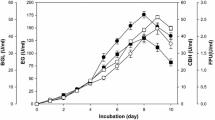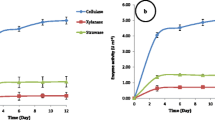Summary
The fermentation profiles ofSporotrichum pulverulentum andDichomitus squalens showed distinct differences.D. squalens digested the substrate more slowly thanSporotrichum pulverulentum. The relative degradation rates of total organic matter and lignin also differed considerably.
Whereas withS. pulverulentum the ratio was about the same throughout the whole observation period, withDichomitus squalens it altered in favour of lignin degradation.
WithSporotrichum pulverulentum an optimum digestion in vitro of 40%–50% was achieved after 20 days of incubation. WithDichomitus squalens the best value (about 60%) was reached after 30 days of incubation. Increasing incubation temperatures enhanced the degradation of the substrate.
As found with wheat straw, all other substrates tested (straw of rape and barley, glumes of rice) were degraded more slowly byDichomitus squalens than bySporotrichum pulverulentum. The degradation rates for oak, spruce and beech sawdust were very low compared to those for straw.
Small amounts of ammonium nitrate stimulated the degradation of straw byS. pulverulentum whereas higher concentrations had an inhibitory effect. The optimum water content of the substrate, measured by decomposition of total organic matter and lignin and by in vitro digestibility, was between 50 and 100 ml of water/25 g substrate. Higher and lower water contents had an unfavourable effect.
Varying the pore size of the substrate by using milled straw of defined particle size had no influence on the 6 parameters tested under the given experimental conditions.
The best method to supress potential competitors was to heat the substrate to 90°C for 24 h.
Similar content being viewed by others
References
Almin KE, Eriksson KE, Pettersson B (1975) Extracellular enzyme system utilized by the fungusSporotrichum pulverulentum (Chrysosporium lignorum) for the breakdown of cellulose. Eur J Biochem 51:207–211
Ander P, Eriksson KE (1976) The importance of phenol oxidase activity in lignin degradation by the white-rot fungusSporotrichum pulverulentum. Arch Microbiol 109:1–8
Ander P, Hatakka A, Eriksson KE (1980) Vanillic acid metabolism by the white-rot fungusSporotrichum pulverulentum. Arch Microbiol 125:189–202
Buswell JA, Ander P, Pettersson B, Eriksson KE (1979) Oxidative decarboxylation of vanillic acid bySporotrichum pulverulentum. FEBS Lett 103:98
Cowling EB, Merrill W (1966) Nitrogen in wood and its role in wood deterioration. Can J Botany 44:1539–1554
Dangulis AG, Bone DH (1978) Production of microbial protein from tree bark byPhanerochaete chrysosporium. Biotechnol Bioeng XX:1639–1649
Enoki A, Goldsby GP, Gold MH (1981)β-ether cleavage of the lignin model compound 4-ethoxy-3-methoxyphenylglycerol-β-guaiacylether and derivatives byPhanerochaete chrysosporium. Arch Microbiol 129:141–145
Eriksson KE, Grünewald A, Vallander L (1980) Studies of growth conditions in wood for three white-rot fungi and their cellulaseless mutants. Biotechnol Bioeng XXII:363–376
Halse OM (1926) Determination of cellulose and wood fiber in paper. Papier J 14:121–126
Hofsten B von, Hofsten A von (1974) Ultrastructure of a thermotolerant basidiomycete possibly suitable for production of food protein. Appl Microbiol 27:1142–1148
Kaneshiro T (1977) Lignocellulosic agricultural wastes degraded byPleurotus ostreatus. Dev Ind Microbiol 18:591–597
Kirk TK, Moore WE (1972) Removing lignin from wood with white rot fungi and digestibility of resulting wood. Wood Fiber 4:72–79
Kirk TK, Schultz E, Connors WJ, Lorenz LF, Zeikus JG (1978) Influence of culture parameters on lignin metabolism byPhanerochaete chrysosporium. Arch Microbiol 117:277–285
Lindenfelser LA, Detroy RW, Ramstack JM, Worden KA (1979) Biological modification of the lignin and cellulose components of wheat straw byPleurotus ostreatus. Dev Ind Microbiol 20:541–551
Maeder H (1960) Chemische und pflanzenphysiologische Untersuchungen mit Rottestroh. Dissertation Justus Liebig-Universität, Gießen
Matteau PP, Bone DH (1980) Solid-state fermentation of maple wood. Biotechnol Letters 2:127–132
Mokrasch LC (1954) Analysis of hexose phosphates and sugar mixtures with the anthrone reagent. J Biol Chemistry 208:55–59
Park D (1976) Carbon and nitrogen levels as factors influencing fungal decomposers. In: Symposium of the British Ecological Society. (Blackwell Scientific Oxford) 17:41–59
Reid ID (1979) The influence of nutrient balance on lignin degradation by the white-rot fungusPhanerochaete chrysosporium. Can J Bot 57:2050–2058
Reid ID, Seifert KA (1980) Lignin degradation byPhanerochaete chrysosporium in hyperbaric oxygen. Can J Bot 26:1168–1171
Streeter CL, Conway KE, Horn GW, Mader TL (1982) Nutritional evaluation of wheat straw incubated with the edible mushroom,Pleurotus ostreatus. J Anim Sci 54:183–188
Tilley JMA, Terry RA (1963) A two stage technique for the in vitro digestibility of forage crops. J Br Grassl Soc 18:104–111
Zadražil F (1980) Influence of Ammonium nitrate and organic supplements on the yield ofPleurotus sajor caju (Fr) Sing. Eur J Appl Microbiol Biotechnol 9:31–35
Zadraîl F, Brunnert H (1978) Der Einfluß verschiedener Stickstoffquellen auf den Abbau von Stroh und den Fruchtkörperertrag vonAgrocybe aegerita. Mushroom Science X (Part I): 843–849
Zadražil F, Brunnert H (1980) The influence of ammonium nitrate supplementation on degradation and in vitro digestibility of straw colonized by higher fungi. Eur J Appl Microbiol Biotechnol 9:37–44
Zadražil F, Brunnert H (1981) Investigation of physical parameters important for the solid state fermentation of straw by white rot fungi. Eur J Appl Microbiol Biotechnol 11:183–188
Zycha H (1939) Der Einfluß stickstoffhaltiger Salze auf die Zerstörung von Bauholz durch Pilze. Angew Botanik 21:455–471
Author information
Authors and Affiliations
Rights and permissions
About this article
Cite this article
Zadražil, F., Brunnert, H. Solid state fermentation of lignocellulose containing plant residues withSporotrichum pulverulentum Nov. andDichomitus squalens (Karst.) Reid.. European J. Appl. Microbiol. Biotechnol. 16, 45–51 (1982). https://doi.org/10.1007/BF01008242
Received:
Issue Date:
DOI: https://doi.org/10.1007/BF01008242




